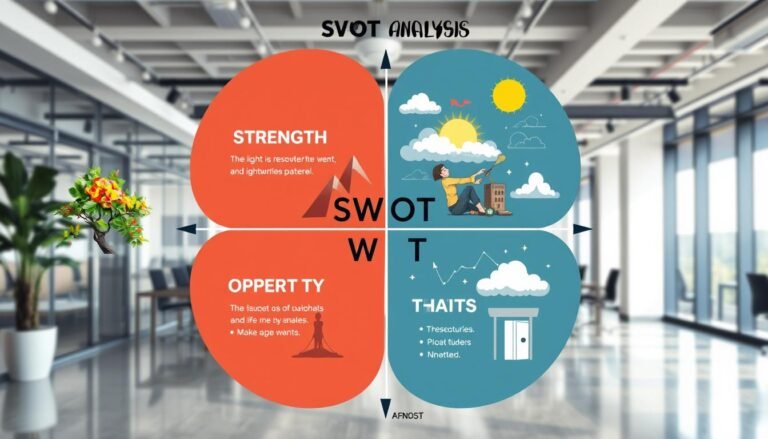Strategic Frameworks – SWOT, PESTLE, and More
Did you know over 70% of businesses struggle with strategic planning? This fact shows how crucial it is to use frameworks like SWOT and PESTLE. In today’s fast-changing markets, these models help companies check their strengths, weaknesses, chances, and threats.
Strategic frameworks are key tools for clear decision-making. They help businesses understand their surroundings and stand out from rivals. This article will explore important frameworks, like SWOT and PESTLE. These tools help companies work better and grow.
Key Takeaways
- Strategic frameworks are essential for structured planning processes.
- SWOT analysis evaluates internal and external factors affecting an organization.
- PESTLE analysis helps understand the broader macro-environmental influences.
- Combining SWOT and PESTLE offers a comprehensive view for strategic decisions.
- Effective use of these frameworks can improve overall business performance.
Understanding Strategic Frameworks
Strategic frameworks are key tools that help organizations make plans that match their goals. They offer different models and methods for various needs and settings. This helps businesses tackle challenges and grab new chances.
Definition of Strategic Frameworks
Strategic management models give structured ways to make strategic decisions. They include tools like SWOT analysis and the PESTLE framework. These tools help businesses look at their strengths and weaknesses, and the market around them. By using these tools, companies can make a plan to reach their goals.
Importance of Strategic Frameworks for Organizations
Using strategic frameworks leads to better decision-making in companies. They help analyze what the company can do well and what the market is like. This helps avoid risks and adapt to changes in the market. Good strategic models also make teams accountable by setting clear goals and metrics.
SWOT Analysis: A Powerful Tool for Businesses
Many companies use SWOT analysis as a key part of their planning. It helps them look at both what’s inside and outside their business. By checking strengths, weaknesses, opportunities, and threats, they can make better choices.
Components of SWOT Analysis
SWOT analysis is a way to look at four main things:
- Strengths: Things like strong brands and skilled processes that help them stand out.
- Weaknesses: Things like old technology or not having enough money that might slow them down.
- Opportunities: Chances to grow outside, like new markets and changes in the industry.
- Threats: Risks like more competition or economic problems that could hurt their business.
How to Effectively Use SWOT Analysis
To make the most of SWOT analysis, companies should focus on what’s most important. They should use their strengths well and work on their weaknesses. Talking to customers can also help by making sure the business strategy matches what people want.
It’s a good idea for companies to do a big SWOT analysis every three to five years. Smaller checks more often can help with short-term issues. Having SWOT workshops with important people helps everyone work together better. Having an expert lead the workshop makes sure all angles are covered.
PESTLE Analysis for Comprehensive Environmental Scanning
PESTLE analysis is key to understanding what affects businesses outside. It looks at many factors to spot important areas that can change how well a business runs and its place in the market. It focuses on six main areas: political, economic, social, technological, legal, and environmental.
Meaning and Components of PESTLE Analysis
PESTLE analysis is strong because it checks many outside factors. Each part is very important:
- Political: Government policies and stability.
- Economic: Growth, interest rates, and how much people spend.
- Social: Changes in people and how they act.
- Technological: New tech that can help businesses work better.
- Legal: Laws that affect how businesses run.
- Environmental: Things related to being green and the planet.
Using PESTLE helps companies see changes in the market and plan for them. With this info, companies can deal with problems and find new chances.
Benefits of Conducting a PESTLE Analysis
Doing a PESTLE analysis has many benefits for companies wanting to plan better and work more efficiently. This deep look at the environment helps with:
- Spotting trends that might change what customers want.
- Seeing risks early to avoid problems in the market.
- Finding new chances from knowing what’s happening outside.
- Helping with making smart choices about entering new markets and creating products.
- Getting ahead of competitors by making smart changes based on the analysis.
Overall, using PESTLE analysis helps companies stay flexible and ready for the changing business world.
Other Strategic Business Models
Strategic frameworks go beyond SWOT and PESTLE. They include a wide range of models that help companies deal with complex situations. For example, Porter’s Five Forces and the Balanced Scorecard offer new ways to look at competition and measure performance. The Stakeholder Theory shows how important it is to value different groups for success.
Overview of Additional Strategic Frameworks
The Value Disciplines framework sorts companies into three main types: operational excellence, customer intimacy, or product leadership. Models like the McKinsey 7S Model and Ansoff Matrix help companies check their strengths and plan for growth. These tools help businesses stay flexible in changing markets and meet stakeholder needs.
When to Use Different Strategic Analysis Tools
Choosing the right framework depends on the company’s goals and situation. For instance, the scenario model is great for looking at external factors. Hofstede’s Cultural Dimensions is useful for planning international moves. Using the right tools at the right time helps in making better decisions and using resources wisely.
Source Links
- City University of Seattle Library: Business & Management: SWOT and PESTLE Analyses
- SWOT vs. PESTEL Analysis: What’s The Difference? | Splunk
- 20 Strategic Frameworks & Models for Business Success 🎯
- A Comprehensive Guide to Strategic Planning Models — Helping Companies Deliver More Value Through Better Process Management | Bob Stanke
- A Comprehensive Guide to PESTEL and SWOT Analysis
- SWOT analysis: An easy tool for strategic planning
- SWOT & PESTLE Analysis
- PESTLE Analysis, PESTLE Analysis Template – GroupMap
- Scanning the Environment: PESTEL Analysis – Planium Pro
- 11 Best Strategic Frameworks For Your Organization
- 7 Strategic Planning Models and 8 Frameworks To Start [2024] • Asana
- Top Business, Strategy and Management Frameworks EXPLAINED | B2U






